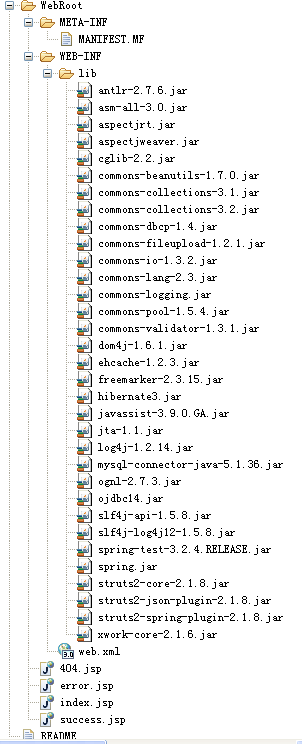SSH项目,架包,源码
2015-11-05 15:10
363 查看
搭建SSH项目,源码示例
在项目中有spring配置Oracle示例,同样也有MySQL的
有关于struts2的拦截器栈配置、全局result配置以及Action的404错误处理等
ps:一个简单的SSH小模版
好了下面是源码示例:首先,新建一个新的Web Project,接着导入项目所需的所有架包
架包如下(源码在最后,包含架包):

然后项目的src目录下
项目包com.ssh.bean下建立实体如下:
package com.ssh.bean;
/**
* Test entity. @author MyEclipse Persistence Tools
*/
public class Test implements java.io.Serializable {
// Fields
private static final long serialVersionUID = 1L;
private Integer id;
private String content;
// Constructors
/** default constructor */
public Test() {
}
/** full constructor */
public Test(String content) {
this.content = content;
}
// Property accessors
public Integer getId() {
return this.id;
}
public void setId(Integer id) {
this.id = id;
}
public String getContent() {
return this.content;
}
public void setContent(String content) {
this.content = content;
}
}Test类的映射文件:
<?xml version="1.0" encoding="utf-8"?> <!DOCTYPE hibernate-mapping PUBLIC "-//Hibernate/Hibernate Mapping DTD 3.0//EN" "http://hibernate.sourceforge.net/hibernate-mapping-3.0.dtd"> <hibernate-mapping> <!-- schema是Oracle数据库的用户名 --> <class name="com.ssh.bean.Test" table="TEST" schema="EJOB"> <id name="id" type="java.lang.Integer"> <column name="ID" precision="5" scale="0" /> <!-- 自增主键 --> <generator class="sequence" /> </id> <property name="content" type="java.lang.String"> <column name="CONTENT" length="10" /> </property> </class> </hibernate-mapping>
接着是拦截器示例,需要在struts.xml文件中配置,看后面struts.xml:
package com.ssh.interceptor;
import com.opensymphony.xwork2.ActionInvocation;
import com.opensymphony.xwork2.interceptor.AbstractInterceptor;
public class MyInterceptor extends AbstractInterceptor {
private static final long serialVersionUID = 1L;
@Override
public String intercept(ActionInvocation invocation) throws Exception {
System.out.println("拦截器拦截!然而并没有做什么!");
return invocation.invoke();
}
}然后是TestAction,如下:
package com.ssh.action;
import org.hibernate.SessionFactory;
import com.opensymphony.xwork2.ActionSupport;
import com.ssh.bean.Test;
public class TestAction extends ActionSupport{
private static final long serialVersionUID = 1L;
private SessionFactory sessionFactory;
public<
e188
/span> SessionFactory getSessionFactory() {
return sessionFactory;
}
public void setSessionFactory(SessionFactory sessionFactory) {
this.sessionFactory = sessionFactory;
}
public String execute(){
Test test = new Test("测试");
Integer id = (Integer) sessionFactory.openSession().save(test);
System.out.println("这是测试Action!保存实体Id:" + id);
return ActionSupport.SUCCESS;
}
}ps:这里省略了service以及Dao接口
在src目录下新建struts.xml如下:
<?xml version="1.0" encoding="UTF-8" ?> <!DOCTYPE struts PUBLIC "-//Apache Software Foundation//DTD Struts Configuration 2.0//EN" "http://struts.apache.org/dtds/struts-2.0.dtd"> <struts> <!-- 指定由spring负责action对象的创建 --> <constant name="struts.objectFactory" value="spring" /> <!-- 所有匹配*.action的请求都由struts2处理 --> <!-- <constant name="struts.action.extension" value="action" /> --> <!-- 是否启用开发模式(开发时设置为true,发布到生产环境后设置为false) --> <constant name="struts.devMode" value="true" /> <!-- 请求参数的编码方式 --> <constant name="struts.i18n.encoding" value="GBK" /> <!-- 文件上传最大值 --> <constant name="struts.multipart.maxSize" value="104857600" /> <package name="ssh" namespace="/ssh" extends="struts-default"> <interceptors> <!-- 拦截器 --> <interceptor class="com.ssh.interceptor.MyInterceptor" name="MyInterceptor" /> <!--定义一个拦截器栈 --> <interceptor-stack name="mydefault"> <!--配置默认拦截器 --> <interceptor-ref name="defaultStack" /> <interceptor-ref name="MyInterceptor" /> </interceptor-stack> </interceptors> <!-- 使用配置的默认拦截器 --> <default-interceptor-ref name="mydefault" /> <!--定义全局Result --> <global-results> <result name="login">/index.jsp</result> <result name="error">/error.jsp</result> </global-results> <action name="Test" class="TestAction"> <result name="success">/success.jsp</result> </action> </package> <!--action的404处理 --> <package name="error" extends="struts-default"> <default-action-ref name="notFound" /> <action name="notFound"> <result>/404.jsp</result> </action> </package> </struts>
新建spring.xml文件如下:
<?xml version="1.0" encoding="UTF-8"?> <beans xmlns="http://www.springframework.org/schema/beans" xmlns:context="http://www.springframework.org/schema/context" xmlns:xsi="http://www.w3.org/2001/XMLSchema-instance" xmlns:aop="http://www.springframework.org/schema/aop" xmlns:tx="http://www.springframework.org/schema/tx" xmlns:p="http://www.springframework.org/schema/p" xmlns:util="http://www.springframework.org/schema/util" xmlns:jdbc="http://www.springframework.org/schema/jdbc" xmlns:cache="http://www.springframework.org/schema/cache" xsi:schemaLocation=" http://www.springframework.org/schema/context http://www.springframework.org/schema/context/spring-context.xsd http://www.springframework.org/schema/beans http://www.springframework.org/schema/beans/spring-beans.xsd http://www.springframework.org/schema/tx http://www.springframework.org/schema/tx/spring-tx.xsd http://www.springframework.org/schema/jdbc http://www.springframework.org/schema/jdbc/spring-jdbc-3.1.xsd http://www.springframework.org/schema/cache http://www.springframework.org/schema/cache/spring-cache-3.1.xsd http://www.springframework.org/schema/aop http://www.springframework.org/schema/aop/spring-aop.xsd http://www.springframework.org/schema/util http://www.springframework.org/schema/util/spring-util.xsd"> <!-- 可以把普通Bean类配置移到spring_bean.xml中,在这里引入文件 --> <!-- <import resource="spring_bean.xml" /> --> <!-- 配置mysql数据库连接 --> <!-- <bean id="dataSource" class="org.apache.commons.dbcp.BasicDataSource"> <property name="driverClassName" value="com.mysql.jdbc.Driver"> </property> <property name="url" value="jdbc:mysql://localhost:3306/test"> </property> <property name="username" value="root"></property> <property name="password" value="123"></property> </bean> --> <!-- 配置oracle数据库连接 --> <bean id="dataSource" class="org.apache.commons.dbcp.BasicDataSource"> <property name="driverClassName" value="oracle.jdbc.driver.OracleDriver"> </property> <!-- jdbc:oracle:thin:@你的IP:端口:数据库 --> <property name="url" value="jdbc:oracle:thin:@localhost:1521:test"> </property> <property name="username" value="root"></property> <property name="password" value="123"></property> </bean> <!-- 配置sessionFactory --> <bean id="sessionFactory" class="org.springframework.orm.hibernate3.LocalSessionFactoryBean"> <property name="dataSource"> <ref bean="dataSource" /> </property> <property name="hibernateProperties"> <props> <prop key="hibernate.current_session_context_class">org.springframework.orm.hibernate3.SpringSessionContext </prop> <!-- <prop key="hibernate.dialect">org.hibernate.dialect.MySQL5Dialect</prop> --> <prop key="hibernate.dialect">org.hibernate.dialect.Oracle10gDialect</prop> <prop key="hibernate.show_sql">true</prop> <prop key="hibernate.hbm2ddl.auto">update</prop> </props> </property> <!-- 配置数据库实体类映射文件,自动扫描整个包 --> <property name="mappingDirectoryLocations"> <list> <value>classpath:com/ssh/bean</value> </list> </property> </bean> <!-- 配置Action --> <bean id="TestAction" class="com.ssh.action.TestAction"> <property name="sessionFactory" ref="sessionFactory" /> </bean> </beans>
在web.xml里配置struts2过滤器,配置spring监听器:
<?xml version="1.0" encoding="UTF-8"?> <web-app version="3.0" xmlns="http://java.sun.com/xml/ns/javaee" xmlns:xsi="http://www.w3.org/2001/XMLSchema-instance" xsi:schemaLocation="http://java.sun.com/xml/ns/javaee http://java.sun.com/xml/ns/javaee/web-app_3_0.xsd"> <display-name></display-name> <welcome-file-list> <welcome-file>index.jsp</welcome-file> </welcome-file-list> <!-- 配置struts过滤器 --> <filter> <filter-name>struts2</filter-name> <filter-class>org.apache.struts2.dispatcher.ng.filter.StrutsPrepareAndExecuteFilter</filter-class> </filter> <filter-mapping> <filter-name>struts2</filter-name> <url-pattern>/*</url-pattern> </filter-mapping> <!-- 配置spring --> <context-param> <param-name>contextConfigLocation</param-name> <param-value>classpath:spring.xml</param-value> </context-param> <listener> <listener-class>org.springframework.web.context.ContextLoaderListener</listener-class> </listener> </web-app>
最后新建几个简单的jsp页面,发布然后运行,访问
http://localhost:8080/ssh_template/ssh/Test.action
会看到如下结果:

控制台输出如下:

源码在这里,点击进入下载
ps:项目的编码是GBK,注意你的workspace的默认编码
相关文章推荐
- 基于 Red Hat 的发行版 Oracle Linux 正式发布Oracle Linux 7.1
- Linux Generating SSH Keys
- 一个jar包里的网站
- 一个jar包里的网站之文件上传
- 一个jar包里的网站之返回对媒体类型
- Oracle Containers for J2EE远程安全漏洞(CVE-2014-0413)
- JQuery+Strusts1.x无刷新登录
- Oracle 10g R2不能使用EM的问题
- 表空间操作
- PreparedStatement中in子句的处理
- VMware下RedHat4.8_64位安装Oracle 10g RAC--简略脚本
- oracle sql日期比较
- 基于 Red Hat 的发行版 Oracle Linux 正式发布Oracle Linux 7.1
- OS block size和Oracle block size,查找OS Blocksize的方法
- oracle中创建数据库和表空间的几点总结
- 数据库自动备份脚本
- oracle的nvl函数的使用介绍
- 解决oracle用户连接失败的解决方法
- oracle的一些tips技巧
